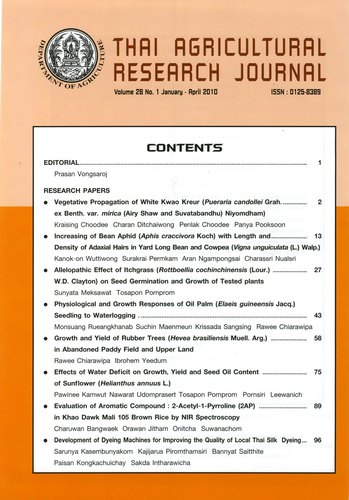Physiological and Growth Responses of oif Palm (Elaeis guineensis Jacq.) Seedling to Waterlogging
DOI:
https://doi.org/10.14456/thaidoa-agres.2010.14Keywords:
physiological response, oil palm seedling, waterlogging, Elaeis guincensisAbstract
An experiment was conducted to investigate the physiological responses and growth of waterlogged oil palm (Elaeis guineensis cv. Suratthanee 2) seedlings at Krabi Oil Palm Research Centre, Klong Thom district, Krabi province during June-November 2008. Thirty oil palm seedlings were grown in 0.57 m<sup>3</sup> cement pot under natural conditions. The experiment was arranged in CRD with 5 treatments. Twelve month-old oil palm seedlings were subjected to continuous waterlogging for 0 (non-waterlogged seedlings), 15, 30, 60 and 90 days, and then drained. Six seedlings were used for each waterlogging treatment. It was found that the effects of 60 and 90 days of waterlogging had lower stomatal conductance, leaf water potential, total chlorophyll content and net photosynthesis than those of non-waterlogged seedlings. Moreover, growth rate (height, number of petiole, cross-section area of petiole and leaf area) and both fresh and dry weights of oil palm seedlings were also markedly decreased as a result of waterlogged condition for 60 and 90 days. Therefore, this study was indicated that long periods (over 60 days) of waterlogging caused a reduction in growth and biomass allocation of oil palm seedlings which ultimately negative affected oil palm productivity.
Downloads
Published
How to Cite
Issue
Section
License
Copyright (c) 2017 วารสารวิชาการเกษตร (Thai Agricultural Research Journal)

This work is licensed under a Creative Commons Attribution-NonCommercial-NoDerivatives 4.0 International License.
Thai Agricultural Research Journal



